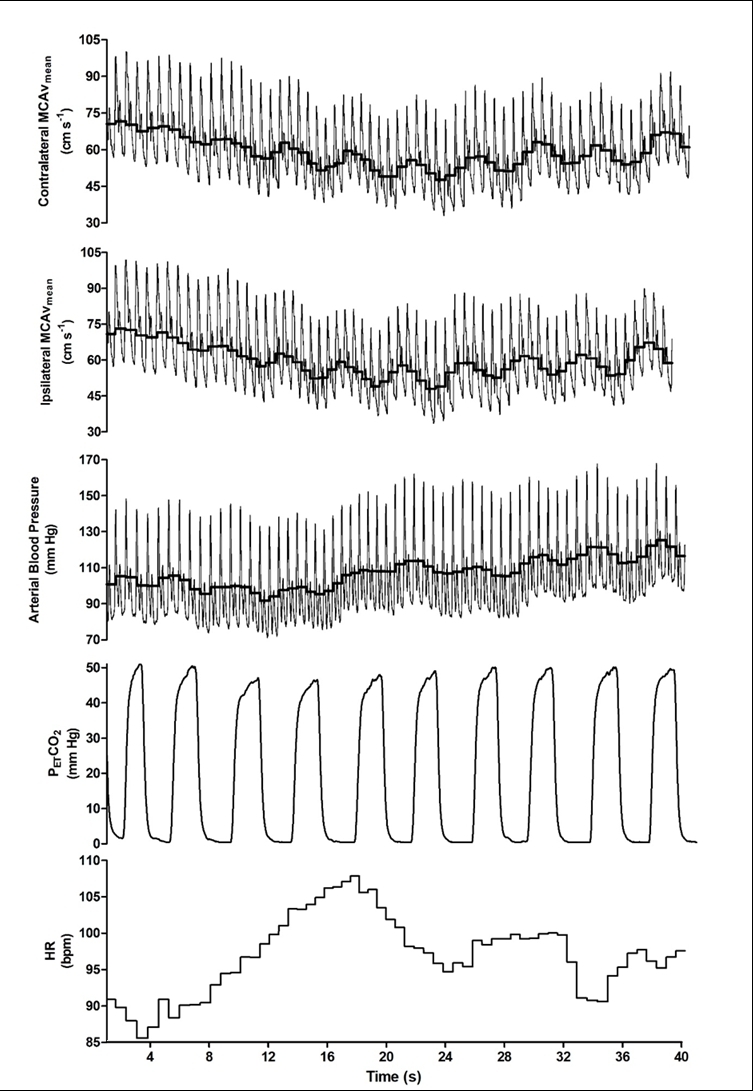During dynamic exercise many of the regulators of cerebral blood flow (CBF) are concomitantly perturbed. These regulators include neurovascular coupling (NVC), arterial carbon dioxide content, arterial blood pressure, sympathetic nerve activity, and cerebral autoregulation (CA). Neurovascular coupling refers to the matching of local CBF to neuronal activity. That is, when neuronal activity increases, so does local blood flow. During unilateral static handgrip exercise blood velocity in the middle cerebral artery (MCAv) contralateral to the exercising limb increases, indicative of NVC. However, it is unknown whether this persists during dynamic resistance exercise (RE). This study aimed to examine the cerebral haemodynamic response to unilateral dynamic upper body RE in healthy individuals. We hypothesied that during unilateral dynamic upper body RE, there will be no differences between contralateral and ipsilateral MCAv due the overriding influence of arterial carbon dioxide concentration and blood pressure. The current study could provide valuable insights for the safe prescription of dynamic RE to those who have suffered cerebrovascular injury. Thirty (female = 16, mean ± SD: age, 26 ± 6 years, height 175 ± 10cm, weight 74 ± 15kg, BMI 24 ± 5kg/m2) healthy individuals completed 4 sets of 10 paced repetitions (15-beats-per-minute) of unilateral bicep curl exercise at 60% of predicted 1 repetition maximum (60% of 1RM 7 ± 3kg). Beat-to-beat blood pressure, bi-lateral MCAv, and the partial pressure of end-tidal carbon dioxide (PETCO2 – as a proxy for arterial CO2) were measured throughout. One-way ANOVA was used to analyse cardiovascular variables, and two-way ANOVA was used to analyse dependent cerebrovascular variables (side x sets, 2×4). Typical cerebrovascular and cardiovascular responses during RE are shown in Figure 1. Within exercise bilateral MCAv, cerebral conductance index, and pulse velocity decreased across the exercise sets (all P <0.001), but no significant interaction effect was observed (all P>0.221) for any dependent variables. Despite the recruitment of a small muscle mass during the bicep curl, we observed sinusoidal fluctuations in MAP typical of dynamic RE. Furthermore, although not significant (all P>0.316), average PETCO2 was ~2 mmHg lower during exercise. The current data indicates no differences between contralateral and ipsilateral MCAv during unilateral dynamic RE, consistent with our hypothesis, but contradicting findings of static RE studies. The effects of NVC were not discernible in the MCAv data, possibly obfuscated by the small reduction in PETCO2 and the fluctuating MAP. Future studies are required to attempt to discern the underlying physiology of local and global CBF during dynamic RE.
Physiology in Focus 2024 (Northumbria University, UK) (2024) Proc Physiol Soc 59, C37
Oral Communications: Neurovascular coupling during dynamic upper body resistance exercise in healthy individuals
Stephanie Korad1, Toby Mundel1, Blake Perry1,
1School of Health Sciences, Massey University Wellington New Zealand, 2School of Sport, Exercise and Nutrition, Massey University Palmerston North New Zealand, 3Department of Kinesiology, Brock University St Catherines Canada,
View other abstracts by:
Where applicable, experiments conform with Society ethical requirements.

